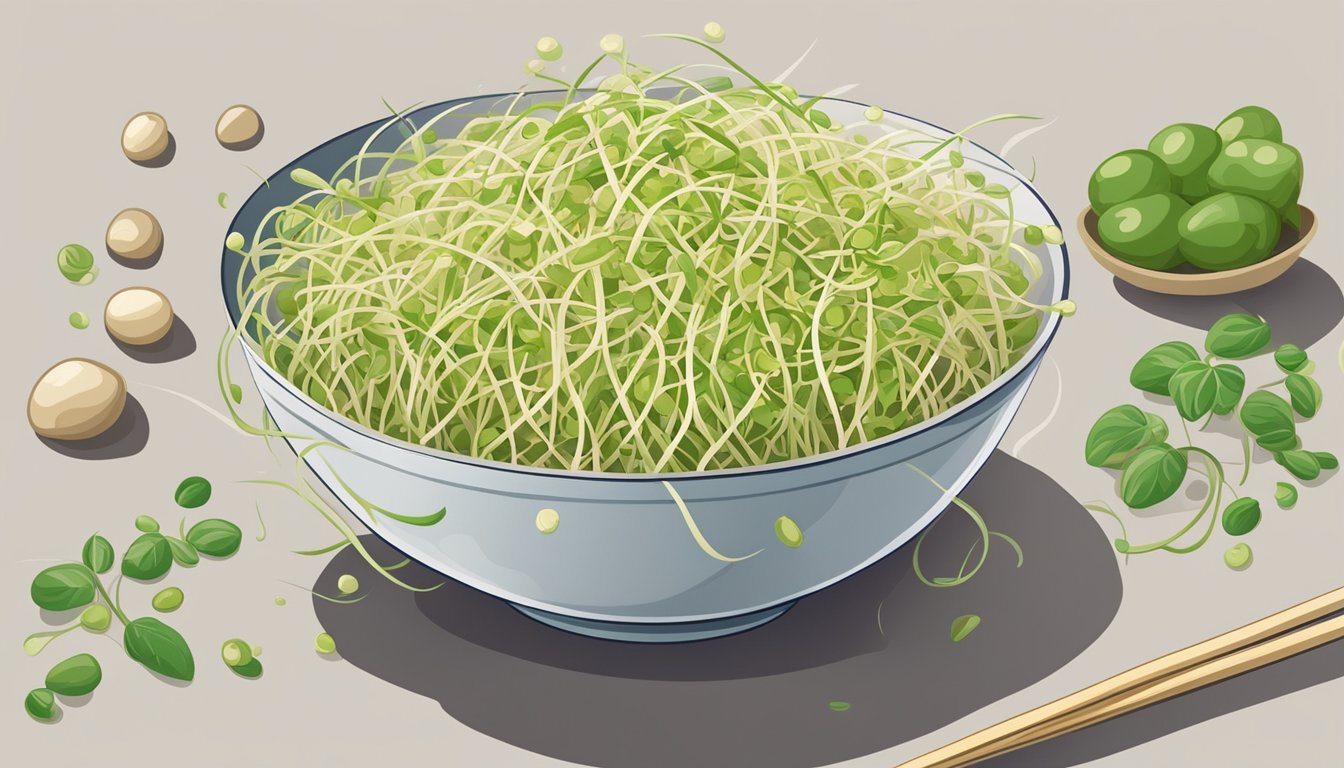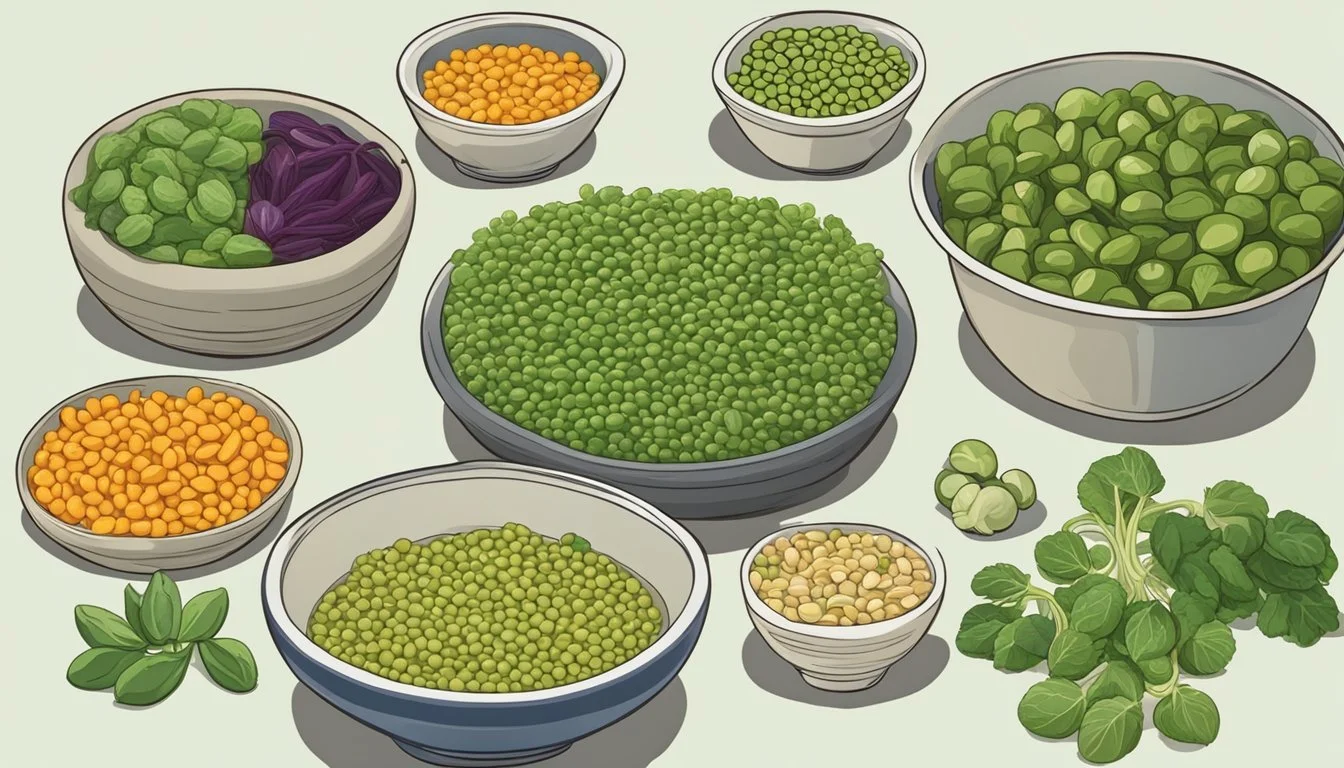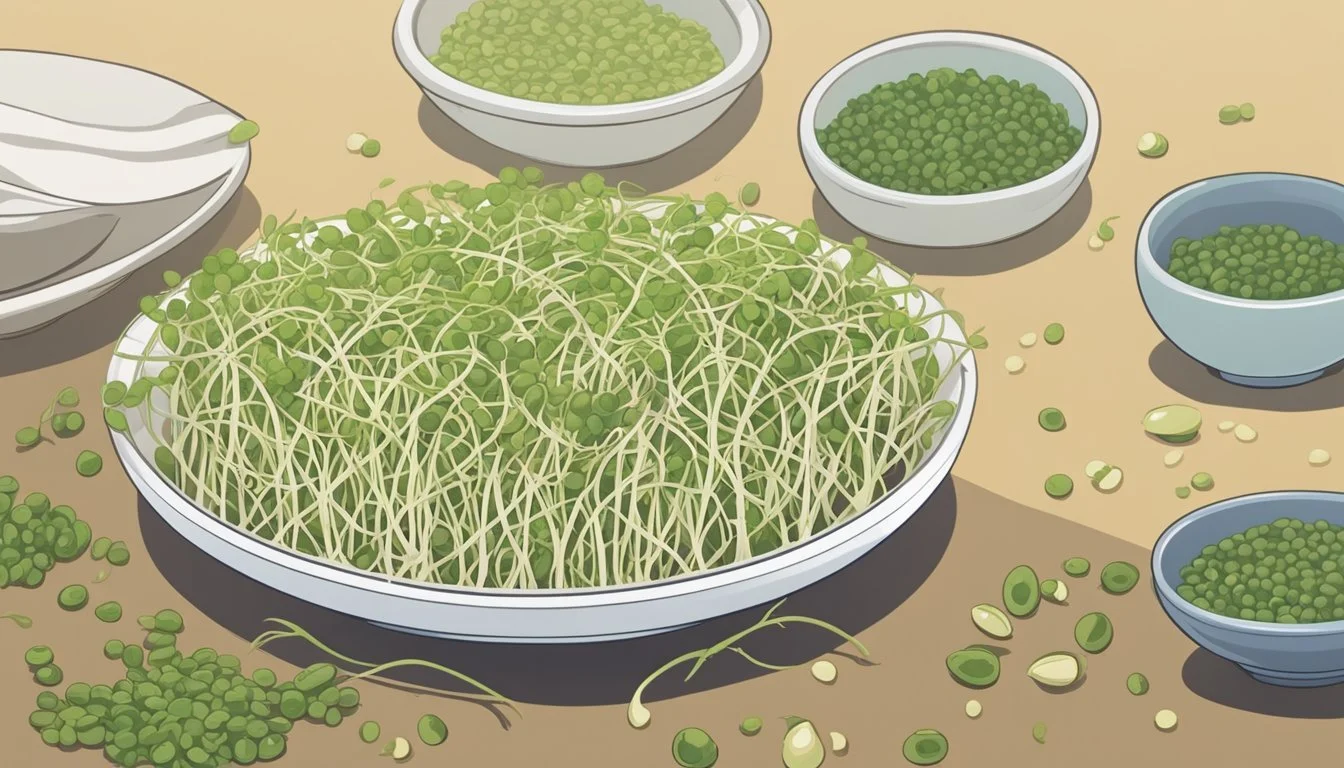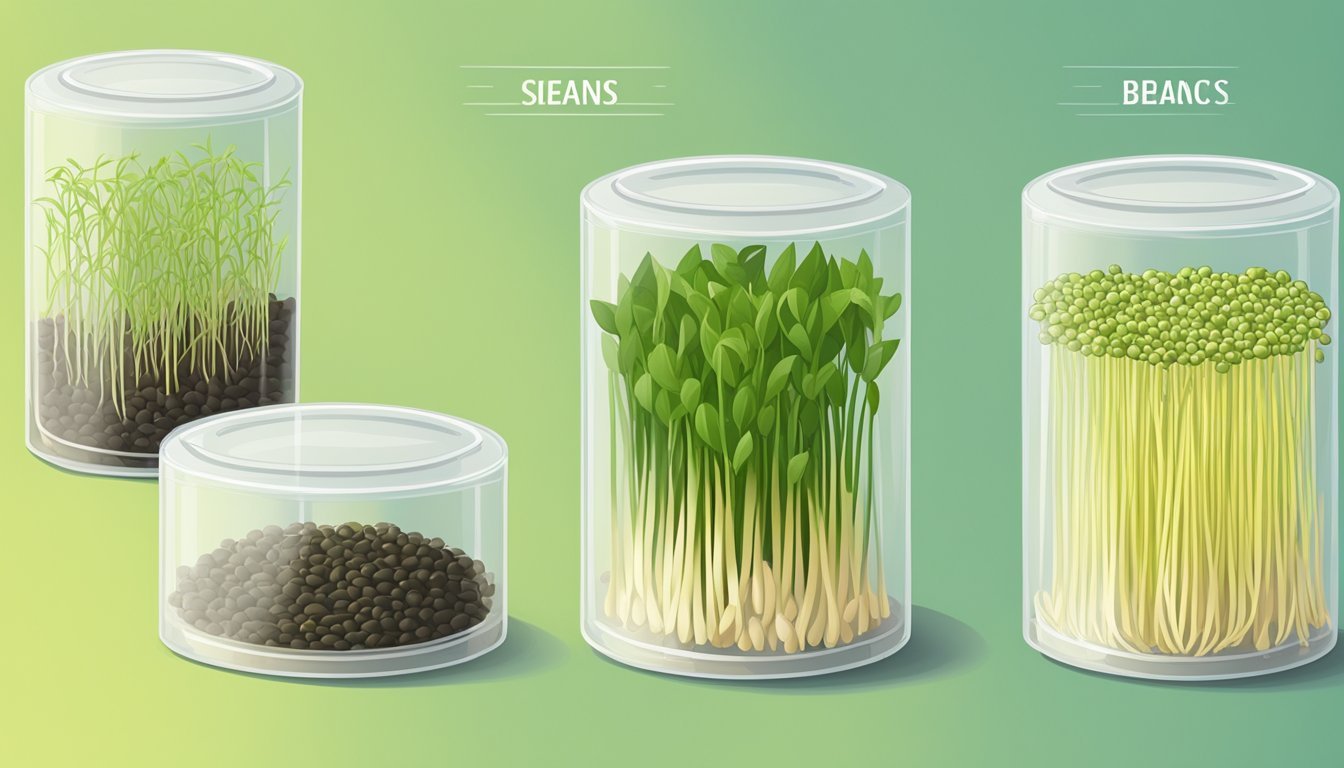How to Substitute Mung Bean Sprouts for Soybean Sprouts
A Simple Guide
Mung bean sprouts have long been a staple in Asian cuisine, cherished for their crunchy texture and subtle flavor. They are an essential ingredient in a variety of dishes, from salads to stir-fries, and are often sought after for their nutritional benefits. The sprouts are derived from germinated mung beans and can be easily grown at home or purchased at most supermarkets. However, there are situations when mung bean sprouts may not be readily available or when consumers might prefer an alternative with similar characteristics.
Soybean sprouts come forward as a fitting substitute for mung bean sprouts due to their comparable crunchy texture and nutritional value. Though slightly different in taste, with a more pronounced bean flavor, soybean sprouts can be used effectively in most recipes that call for their mung bean counterparts. The physical differences are noticeable—soybean sprouts have larger heads and are generally thicker, which might require slight adjustments in cooking time. They are also versatile and offer a robust presence in dishes where a more substantial texture is desired.
Understanding Bean Sprouts
Bean sprouts refer to the tender, edible shoots that come from germinating beans. They are commonly encountered in various cuisines, especially within East Asian dishes. Rich in nutrients and low in calories, they are favored for their unique texture and subtle flavor.
Among the array of sprouts, mung bean sprouts and soybean sprouts are two popular varieties. Mung beans are part of the legume family, and when sprouted, they produce a slender, crunchy shoot with a delicate taste. Soybean sprouts, also from the legume family, are recognizable by their larger head and thicker, longer stems.
Here's a brief comparison:
Mung bean sprouts: Light, crunchy, with a slightly sweet taste.
Soybean sprouts: More robust, with a nuttier flavor and substantial texture.
Mung Bean Sprouts Soybean Sprouts Family Legume Legume Texture Slender and crunchy Thicker and robust Taste Delicate and slightly sweet Nutter and more pronounced
It's important to note that while both sprouts derive from the legume family, each has distinct characteristics that should be considered when substituting one for the other in recipes. Mung bean sprouts are often used in salads, spring rolls, and soups, while soybean sprouts are frequently found in stir-fries and can stand up to longer cooking times.
Nutritional Comparison
In comparing the nutritional profiles of mung bean sprouts and soybean sprouts, it is important to examine specific attributes such as protein content and the range of vitamins and minerals they provide.
Protein Content
Mung Bean Sprouts: Contain approximately 22% protein by weight. For a serving size of six ounces, they provide around 2 grams of protein.
Soybean Sprouts: Are richer in protein, offering between 20-25% of vegetable protein. In a six-ounce serving, soybean sprouts have around 9 grams of protein.
Vitamin and Mineral Content
Mung Bean Sprouts: Are a good source of Vitamin C and contain a variety of minerals beneficial for health. They also include some antioxidant properties.
Soybean Sprouts: While they have vitamins and minerals, they particularly stand out for their higher caloric content due to their larger heads and longer stems.
Both types of sprouts contribute valuable nutrients, including fiber, which is crucial for digestive health. Neither should be considered a sole source of nutrition, but rather as a part of a well-balanced diet.
Culinary Applications
When substituting mung bean sprouts for soybean sprouts, it is important to consider the specific culinary application to achieve the desired texture and flavor in various dishes.
Salads and Sandwiches
In salads and sandwiches, soybean sprouts can serve as a crunchy, nutritious addition. For a classic salad, one might mix soybean sprouts with lettuce, tomatoes, carrots, and bell peppers, enhancing the dish with a variety of textures. Sandwiches benefit from the crunch and slight nuttiness of soybean sprouts, especially when paired with proteins like tofu or chicken.
Example Salad Recipe:
Lettuce
Diced tomatoes
Sliced carrots
Soybean sprouts
Cubed bell peppers
Vinaigrette dressing
Sandwich Layering Suggestion:
Whole grain bread
Mayonnaise or mustard
Sliced chicken or tofu
Soybean sprouts
Sliced tomatoes and avocado
Soups and Stir Fry
Soups and stir-fry dishes are ideal for incorporating soybean sprouts. In soups like pho or ramen, they should be added towards the end of the cooking process to maintain their crispness. For stir-fry dishes, pairing soybean sprouts with vegetables such as bok choy, mushrooms, and bamboo shoots provides a medley of flavors.
Stir-Fry Vegetables:
Bok choy, sliced
Enoki mushrooms
Bamboo shoots
Soybean sprouts
Sauce (soy, oyster, garlic, etc.)
Asian Cuisine and Special Dishes
Asian cuisine often features soybean sprouts in dishes like pad thai, spring rolls, and chop suey. They must be cooked just right; overcooking can lead to a loss of their characteristic crunch. When preparing noodles or spring rolls, adding soybean sprouts along with vegetables like zucchini, celery, or napa cabbage ensures a mix of texture and flavor that's true to the culinary traditions of countries such as Thailand and Japan.
Pad Thai Ingredient List:
Rice noodles
Protein (chicken, shrimp, tofu)
Soybean sprouts
Green cabbage
Peanuts, lime, and cilantro for garnish
Pad thai sauce (tamarind, fish sauce, sugar, chili)
The Art of Substitution
Substituting mung bean sprouts with soybean sprouts is a culinary practice embraced for various reasons, such as availability or personal taste preferences. Both sprouts come from legume families but offer discernibly different textures and flavors.
Soybean Sprouts:
Flavor: Slightly stronger, more bean-like aroma.
Texture: Chewier and thicker than their mung bean counterparts.
Preparation: Soaking overnight is advisable to ensure even cooking.
Mung Bean Sprouts:
Flavor: Milder, often preferred in salads and fresh rolls.
Texture: Crisp and light.
Preparation: Generally used raw or lightly cooked.
The substitution should consider these differences to attain the desired culinary result. When substituting in recipes, it’s important to take into account the unique characteristics of soybean sprouts.
In soups or stir-frys, simply replace them on a one-to-one basis.
For fresh applications like salads, one may need to slightly blanch soybean sprouts to soften their chewier texture.
Here is a brief guide on substitution quantities:
Dish Type Mung Bean Sprouts Soybean Sprouts Substitute Soups 1 cup 1 cup Stir-frys 1 cup 1 cup Salads (raw) 1 cup 1 cup (blanched) Spring Rolls (raw) 1 cup 1 cup (blanched)
Chefs should adjust these quantities to their taste, considering the more pronounced flavor of soybean sprouts. The goal is to achieve a balance that pleases the palate while maintaining the integrity of the dish.
Textural and Flavor Considerations
When substituting mung bean sprouts for soybean sprouts, one must take into account the textural differences and flavor profiles of these two ingredients. Mung bean sprouts typically have a lighter crunch compared to soybean sprouts. In contrast, soybean sprouts offer a firmer bite which can be crucial in dishes that require a substantial textural component.
In terms of flavor, mung bean sprouts exhibit a slightly nutty and sweet taste, which may be less pronounced than that of soybean sprouts. Soybean sprouts have a markedly nuttier flavor which can stand out in a dish.
Aspect Mung Bean Sprouts Soybean Sprouts Texture Lighter crunch Firmer bite Flavor Subtly nutty and sweet Distinctly nuttier
It's important to consider the role of sprouts in the dish being prepared. If sprouts are primarily for a crunchy element, mung bean sprouts can suffice, but their texture may not be as prominent. However, for a nuttier taste, additional seasonings might be needed to mimic the stronger flavor of soybean sprouts.
One should also note the size and shape of these sprouts, as mung bean sprouts are generally smaller and thinner, which could affect the dish's final presentation. Chefs may need to slightly tweak the quantity of mung bean sprouts used in recipes to achieve a similar volume and textural impact as their soybean counterparts.
These considerations are critical in ensuring the desired outcome in both the texture and flavor profile of the culinary creation.
Finding and Selecting Substitutes
When replacing mung bean sprouts with soybean sprouts, finding the right substitute involves considering availability and how the alternative will perform in both raw and cooked applications. The following subsections elaborate on these aspects to guide one through the selection process.
Market Availability
Mung Bean Sprouts: Mung bean sprouts are often found fresh in many grocery stores and markets, primarily in areas with a significant demand for Asian produce. They should be clean, white, and crisp. Outside of Asian markets, one might also find them in health food stores or well-stocked produce sections.
Soybean Sprouts: Less common than mung bean sprouts, soybean sprouts may not be available in all markets. When present, they typically appear alongside other sprouts or in specialty Asian food stores.
Alternative Fresh Substitutes:
Enoki mushrooms, when sliced, can mimic the mild flavor and crunch of mung bean sprouts.
Cabbage, when finely shredded, offers a readily available substitute with a similar texture.
Sunflower sprouts can serve as a stand-in with a more distinct and nutty taste.
Canned Alternatives:
Canned bean sprouts can be used if fresh sprouts are unavailable. Drain and rinse well before use.
Considerations for Raw and Cooked Dishes
Raw Dishes: For salads or fresh spring rolls, substitutes must retain a certain level of crunch after being sliced thinly. Enoki mushrooms and shredded cabbage work well in this regard, providing the necessary texture without overpowering the dish.
Substitute Texture Taste Enoki mushrooms Crunchy, Delicate Mild Shredded Cabbage Crispy Neutral Sunflower Sprouts Crunchy Nutty
Cooked Dishes: When cooked, alternatives should resemble the texture and flavor profile of mung bean sprouts. Enoki mushrooms, bamboo shoots, and water chestnuts maintain their structure and provide a comparable crunch in stir-fry dishes.
Bamboo Shoots: Available canned or fresh, they should be sliced to match the size and shape of mung bean sprouts.
Water Chestnuts: Commonly found canned, they add a signature sweetness. Slice them thinly for a texture that stays firm when heated.
Using these alternatives requires balancing flavor with texture to match the original qualities of mung bean sprouts in both raw and cooked soybean sprout dishes.
Preparing the Substitute
When substituting soybean sprouts for mung bean sprouts, one should first consider the textural differences. Soybean sprouts are generally heartier with a larger head, and their stems are skinnier and longer. For a closer match to the delicate texture of mung bean sprouts:
Trimming: Trim the ends of the soybean sprouts lightly to reduce the bulk and emulate the more slender profile of mung bean sprouts.
Blanching: Blanch the soybean sprouts in boiling water for about 30 seconds to soften the texture, then plunge them into ice water to stop the cooking process.
To mimic the slightly sweet and nutty taste of mung bean sprouts, adding subtle flavors helps:
Garlic: Incorporate a hint of crushed garlic to the cooking process of the soybean sprouts to add a layer of depth to their flavor.
Salt: Use a pinch of salt while blanching to infuse the soybean sprouts with a mild savory touch.
For homemade bean sprout enthusiasts looking to replicate mung bean sprouts using soybeans:
Soaking: Soak soybeans overnight, ensuring they are fully submerged.
Rinsing: Rinse the soybeans thoroughly and drain.
Incubating: Keep the soaked soybeans in a warm, moist environment for 2-5 days, rinsing them every 12 hours to encourage sprouting.
These steps enhance the soybean sprouts' likeness to mung bean sprouts in terms of both taste and texture, allowing them to seamlessly integrate into dishes traditionally calling for mung bean sprouts.
Health Considerations
When substituting mung bean sprouts for soybean sprouts, individuals should consider the health implications associated with both types of sprouts.
Nutritional Content: Both sprouts are low in calories and provide a range of essential nutrients, albeit in varying amounts. Soybean sprouts typically contain higher levels of protein compared to mung bean sprouts, making them favorable for individuals seeking to increase their protein intake.
Vitamins and Minerals: In terms of vitamins, both sprouts are sources of Vitamin C, with soybean sprouts offering a more substantial amount. This can be particularly beneficial for supporting the immune system. Furthermore, they both contain an array of minerals essential for body functions.
Dietary Fiber: Fiber is vital for digestive health, and both types of sprouts contribute to the daily recommended intake of fiber. However, mung bean sprouts have a slight edge in fiber content, which can aid in better digestion and satiety.
Antioxidant Properties: Sprouts are known for their antioxidants that combat oxidative stress in the body. While both mung bean and soybean sprouts contain these properties, the specific types and concentrations of antioxidants may vary, with mung bean sprouts commonly recognized for their detoxifying effects.
Here is a simplified comparison:
Nutrient Mung Bean Sprouts Soybean Sprouts Calories Low Low Protein Moderate Higher Vitamin C Present More Present Minerals Varied Varied Fiber Higher Moderate Antioxidants Present Present
For individuals considering dietary requirements and specific health goals, these nutritional differences should be factored into making informed choices regarding sprout substitution.
Conclusion
When substituting mung bean sprouts for soybean sprouts, the cook should be aware of the slight differences in flavor and texture between the two. Mung bean sprouts tend to be slightly softer and have a milder taste compared to the nuttier flavor of soybean sprouts. Yet, these differences are subtle enough that they are often interchangeable in recipes.
The key considerations when making a substitution are:
Texture: Mung bean sprouts may cook slightly faster due to their tenderness.
Flavor: Adjust seasoning slightly to compensate for the milder taste of mung bean sprouts.
Nutritional Content: Both sprouts offer nutritional benefits, but soybean sprouts have higher protein content.
To ensure a seamless substitution, one might use mung bean sprouts in:
Salads
Stir-fries
Soups
Sandwiches
Wraps
Regardless of the dish, the substitution should maintain the structural integrity and contribute to the overall flavor profile without compromising the dish's original intent. Chefs and home cooks can confidently use mung bean sprouts in place of soybean sprouts, embracing the subtle variances as a natural part of culinary adaptation.










